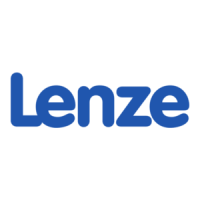Function library
Limit value setting
7−22
L
EDB82MV752 EN 5.2
Adjustment
Relation between output frequency and synchronous speed of the motor:
n
rsyn
C0011 60
p
r
rsyn
Synchronous motor speed [min
−1
]
C0011 Max. output frequency [Hz]
p No. of pole pairs (1, 2, 3, ...)
Example:
4−pole asynchronous motor: p = 2, C0011 = 50 Hz
n
rsyn
50 60
2
1500 min
1
C0010
"Minimum output frequency" characteristics:
C0010 is approached via the acceleration ramp.
C0010 has no effect
– on the analog input 2 of the application I/O.
– when the setpoint is selected via frequency input.
C0010 C0011:
– C0011 is approached via the acceleration ramp regardless of the selected analog setpoint.
– The output frequency is limited to C0011.
– The analog input gain must be set to zero (C0027 = 0), to ensure a trouble−free operation.
C0011
"Maximum output frequency" characteristics:
When selecting fixed setpoint (JOG) C0011 acts as limitation.
C0011 is an internal normalisation variable! Bigger changes should only be made when the
controller is inhibited!
( Stop!
Set C0011 so that the maximum permissible motor speed will not be exceeded.
Otherwise the motor can be destroyed.
C0239
"Lower frequency limitation" characteristics:
When using standard I/O, C0239 is approached without acceleration ramp (jolt!). When using
application I/O, C0236 can be used to set an acceleration time for C0239.
C0239 = 0.00 Hz only allows one direction of rotation.
Tip
For output frequencies > 300Hz, switching frequencies < 8kHz must be avoided.
The display values of C0010 and C0011 can be related to a process variable under C0500
and C0501.

